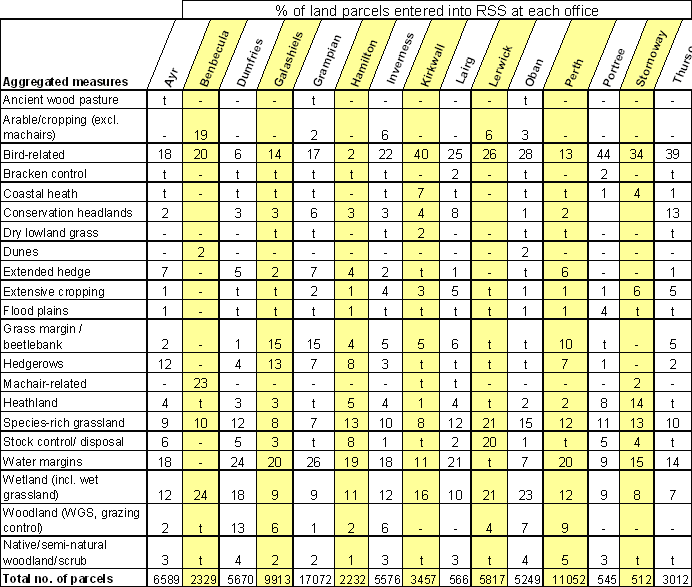
THE STATE OF SCOTLAND'S FARMED ENVIRONMENT 2005
22. RURAL STEWARDSHIP SCHEME
Uptake
Uptake of the RSS has increased from only 49 agreements in 2001 to 2713 participants in 2004 at a cost of £11.5 million ( see Table in CPS briefing note). There are regional differences in the numbers of areas entered under different options (Table 22.2) - for brevity, these have been aggregated into broader topics in the table.
Table 22.2 shows the total numbers of areas (regardless of size) under different management options for vegetation registered with each SEERAD regional office by February 2005. Results are given in percentages of all entries handled by that office (for example, 18% of all the land parcels entered into the scheme at the Ayr office were associated with bird-related measures). Measures accounting for less than 1% are denoted with by ‘t’. Note that the baseline counts were of every individual area entered into the scheme so there can be more than one per farm.
Some of regional differences clearly relate to the occurrence of particular features in an office’s region (e.g. high uptake of machair measures in the Benbecula office), but others probably reflect, at least in part, farmers’ preferences e.g. the low percentage of bird-related measures in Dumfries and the small number of moorland management areas for Lerwick.
Table 22.2 : RSS entries to February 2005- the number of areas of land of different features as a percentage of all areas of land entered into scheme at individual SEERAD area offices. (Percentages less than 1 shown as ‘t’).

Source: Data provided by SEERAD
As ESA agreements come to an end and former ESA participants enter the RSS, some of the regional differences shown above will probably be affected by (a) the regional distribution of the ESAs themselves and (b) differences between ESAs in the list of priority features for Tier 2 ESA measures, which would be carried over into RSS agreements.
Evaluation
At present in the scoring system high weighting is given to the diversity of habitats included in the plan, without taking any direct account of environmental quality. Consequently some large farms and estates will be highly competitive because of the diversity of habitats present. This concentration of expenditure may represent high value for money by targeting payments to high-environmental gain sites. However, this needs to be evaluated. It may be that such concentration is less than ideal from a rural development perspective. For example, it is possible that a wider spread of expenditure would be associated with greater employment benefits.
The scoring system favours large ecologically diverse holdings and makes it difficult for land with a limited range of habitats to enter even if these are of exceptional quality. Pressure from crofters who found it difficult to enter the CPS has resulted in special prescriptions for small units (<10 ha inbye) in the RSS and this increases their chance of successful application. Lack of transparency is another major criticism of the scoring system. Some farmers may not know how many points are required to secure entry into the scheme. IACS businesses already involved in other agri-environment, conservation or woodland schemes are given additional points.
The lack of monitoring information makes it difficult to determine the influence of management prescriptions on environmental outcomes as there is no direct evidence available, yet. As outlined above the choice of the measures depends at least to some extent on farmers’ preferences. Cases such as the highest uptake of the conservation headlands option administered by the Lairg and Thurso offices suggests that the RSS may be promoting maintenance or enhancement of features and habitats that are not a major component of the landscape in that region. Whether this is environmentally positive or negative that will depend on whether these rarer features are seen as important for the environment in that specific region. Furthermore, bracken measures, although a widespread problem particular in warmer and wetter regions, have not been popular and the uptake has generally been rather low, except in Galashiels and Inverness area with 22 land parcels entered.
For most RSS optional management measures, there is an underlying presumption for changes in management practices. But changes might not always be appropriate, e.g. for sites of high biodiversity. Such necessary assessments of potential changes in management emphasizes the need for highly skilled advisors, if the correct option is to be selected for a site, particularly grazing options e.g. for wetlands. That skill is also necessary for assessing progress and more flexibility is required to change options if the wrong one has been selected.
A current review of the RSS is undertaken by SEERAD in collaboration with stakeholders assessing which options can and should be included in Tier 3 of the LMCs and what changes and revisions are required and desirable.Sources
Anon. (2004). The Rural Stewardship Scheme. Scottish Executive, Edinburgh, 125pp.
DEFRA (2002b). Economic evaluation of agri-environment schemes. Report to DEFRA by Centre for Rural Economics Research, University of Cambridge & CJC Consulting, Oxford .
ORGANIC AID SCHEME >>


